
An app for conversations
in a foreign languageFrom ideation to prototype
WORK
The whole UX process from reasearch to prototype
MY ROLE
- UX Researcher
- UX Designer
- UI Designer
WHAT IT WAS ALL ABOUT
I explored the opportunity to improve listening comprehension and conversation skills for foreign language learners, through an engaging and pragmatic experience.
#nativeApps#foreignLanguage#onlineConversation
INTRODUCTION
When starting a user research process, I love to get my very first inspiration while observing people around me in “safari mode”.
I just go out, look around and listen, trying to get some inspiration related to my research area.
In this case, I took advantage of the opportunity to observe, for a few days, a guy that used to sit in the train compartment with me while commuting, who often got engaged in conversations in English with tourists (traveling from Amalfi coast or Sorrento to Naples). A few minutes of listening were enough to realize that, despite of his good intentions, he had a lower-intermediate proficiency in spoken English with a pretty poor dictionary and native language interferences, that made those conversations awkward. After silently observing this guy for a few days, I approached him and I got my first interview done!
THE CONCEPT
A conversation platform that let learners practice a foreign language in a quickly accessible and engaging way.
A BRIEF AND A CHALLENGE
Through research, I learned that for work, study or leisure most of the educated population are aware that they need to improve their linguistic skills in a L2, beyond those standard course lessons, centered on writing, translation, reading and all those activities based on non-interactive/dialog teaching methodology.
Insightful user needs
- People need to acquire fluency in a L2 for work, study, leisure or for personal interests.
- People need a way to get increasingly exposed to new structures of everyday use, when learning and practicing a L2.
- People need to overcome their reticency in speaking a L2 to strangers.
- People need a lot of practice with a L2 to build sentences in a fluent and natural way.
- People, who study or have been studying a L2, need a way to practice it in a daily and continuous process, that goes beyond the duration of foreign language course lessons.
- People need to learn a L2 or improve it by practicing authentic conversations with another speaker, in a real-time environment.
- People need to practice conversations in a L2, while being able to manage the frequency of occurrence.
- People need to find a L2 native speaker to interact with and engage in conversations in a quick and simple way.
- People need to get used to different accents when learning a L2.
- People need to find a way to practice conversation about different topics, based on personal or professional needs and interests.
- Native speakers, while engaging in conversations with speakers, who are learning their native language, need a way to get motivated in helping those learners.
- Each participant in a linguistic exchange centered on conversation need a way to search for a partner based on his/her availability, proficency, interests and more.
- Each person who wish to engage in a conversation with a native L2 speaker need a way to schedule a session or find a conversation partner that is available right away.
- L2 learners need a way to find conversation partners that match their needs and speak to them in a compact and easy to use environment to keep their focus on verbal communication.
- L2 learners need to get motivated and engage in conversations with L2 native speakers to make sure they keep up in their learning process.
I pinned on my inspiration board quite a few items both digital and physical. I also produced a list of 13 words related to my design idea.

This step in the process gave the final shape to my POV: "Everyone should be able to improve his/her linguistic skills, in any L2, being able to practice conversation and listening in a real-time environment with native speakers that they can pick, as if they were a partner for a date".
MAIN FEATURES
My storyboards and paper-prototypes were about two different features for the app: one was for performing an instant voiceChat and the other was for scheduling a voiceChat. Some focus was also put on a feedback and review system for both learners and natives.
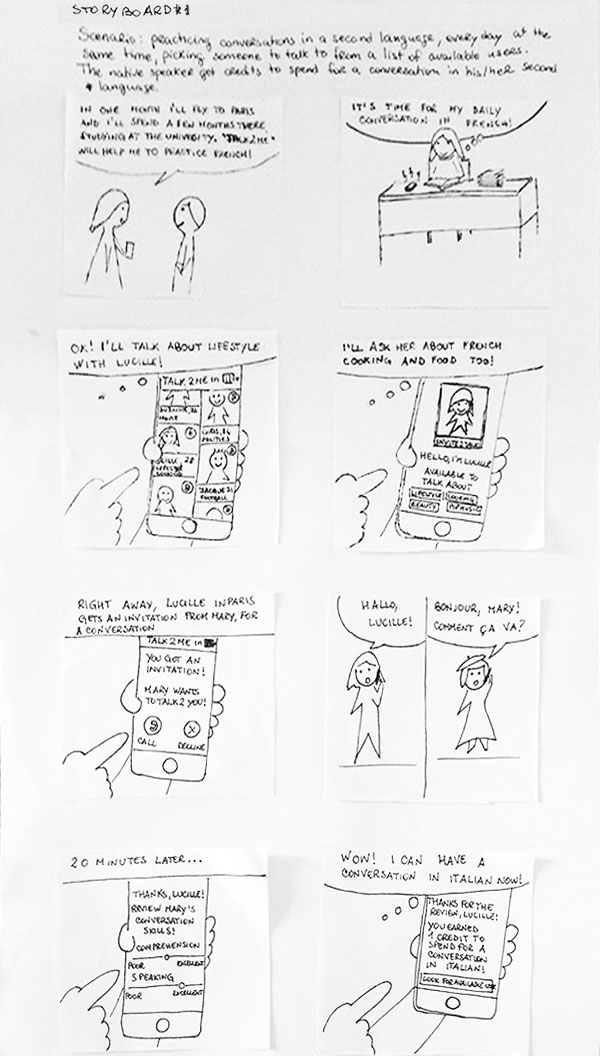
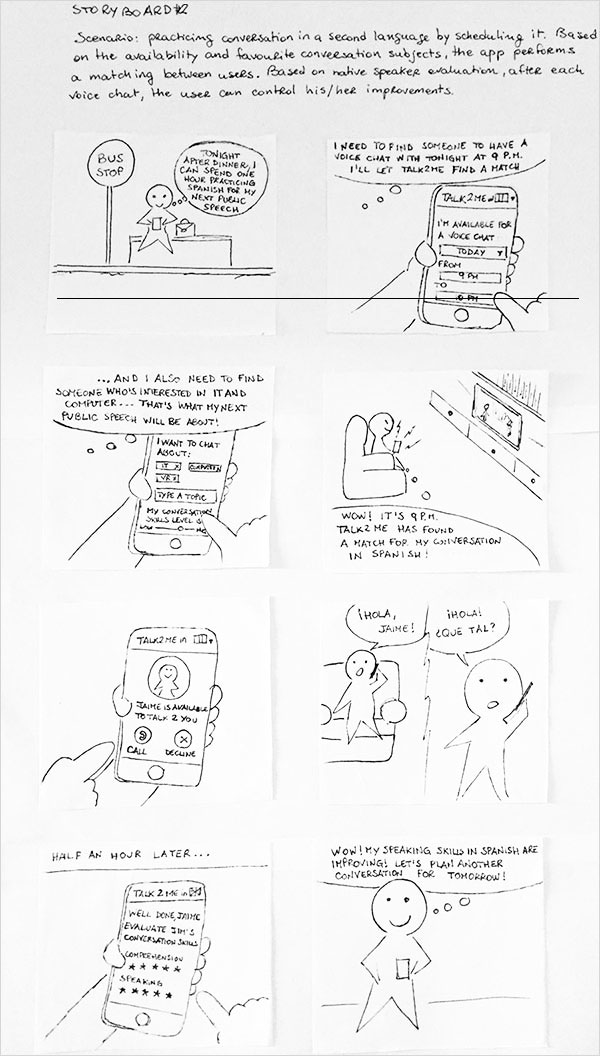
I made two paper prototypes out of these storyboards and I was ready to start the first in-person evaluation session. At this stage, I was able to find out some weak points in the architecture of the app. A precious Hang-out session with Carlos, another UX designer that sometimes I partner with, gave me the opportunity to conduct some extra iterations. He was able to find quite a few useful heuristic violations, that he suggested me to fix.
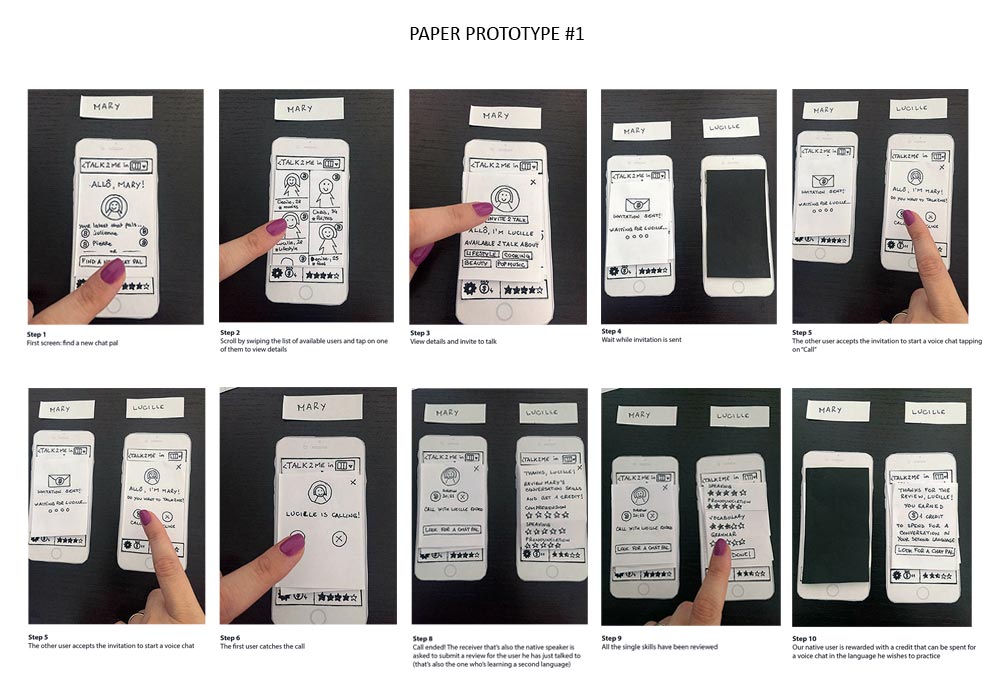
HEURISTIC EVALUATION
Learnings from early testing
The major problems that both me and my Heuristic Evaluation partner identified in both of my prototypes were about navigation, most violations were related to freedom and visibility domains. When you build an app with a quite complex activity flow, you have to pay attention to the navigation architecture, both to avoid dead-ends and to make the experience natural and consistent based on users mental models and expectations. Me and my HE partner also brainstormed for potential solutions while coming across some critical points in the navigation flow. Also a reflection about how to make the best out of the action-bar and the footer menu was needed, because in those areas there should be all those buttons that can be useful to let the user get to some other area of the app in a smooth and fluid way every time he wants to move on to another task.

FROM PAPER TO DIGITAL PROTOTYPE
The iterative process
My prototype was made with inVision. I soon realized that I was facing a pretty tough challenge. It was a huge work and week after week, I added some stretch goals to complete as much as I could, out of the two main core features. My final prototype was made of 99 screens all designed and put together to simulate the experience of scheduling a voiceChat, the experience of performing an instant voiceChat, the one of getting notified and perform a scheduled chat, as well as the one of leaving a review to a learner and getting a feedback about proficiency level from a native.
My final stretch goal was to add the sign up process. At the beginning, to make this part quick and easy, I had provided the app with a “Login with Facebook” button, but some of my user testing participants, both the ones I met in-person and, later on, some of those that I observed in remote recorded video sessions didn’t seem to be comfortable at logging in with their Facebook account. This could be a stumbling block, resulting in the loss of potential users with a high bounce rate, at the very first launch of the application.
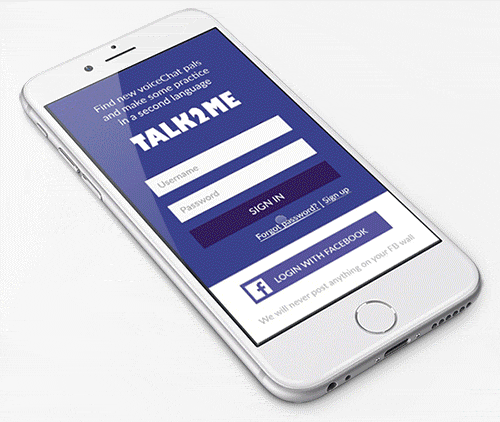
AN A/B TEST
Will they get it? Will it work?
Our last activity in all this UX design process was to launch an A/B test that had to be performed on usertesting.com
I had to A/B test a specific element of my UI. In this application users need to build a reputation based on social proof. Feedbacks/reviews are important to users, both as learners and as natives and to building a solid context for the user experience in the application. Thanks to my in-person user-testing sessions, I had realized that it’s important to remind the user about his coin balance at the end of the call and push him to leave a review for his chat pal with a call-to-action that includes a promise for a reward (earn coins that he can use for the next voiceChat). My A/B testing was meant to prove whether a more straightforward call-to-action on the “Leave a review” button was more effective in persuading users to leave a review for their voiceChat pal.
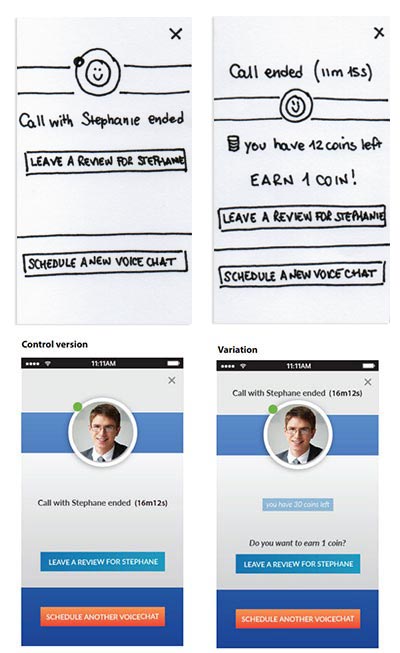
Remote Testing on usertesting.com
During the online testing sessions on usertesting.com, it was amazing to see how different people can follow different interaction patterns. Two participants freely explored the whole app and it sounded like they really enjoyed it! One of them, said in her final considerations:”I immediately found the app interesting and started to press all about to find out what it was about”. Also those interactions that were not part of the main tasks, set for the test (schedule a voiceChat), seemed to have a quite clear UI. All of the participants' comments were very enthusiastic about the service provided by the app as well as about how easy to navigate it was. This final experience just proved how worthwhile all the walkthroughs and the revisions made during the previous weeks had been. After that, I just made the final last tweaks and get the prototype ready for you to try it!


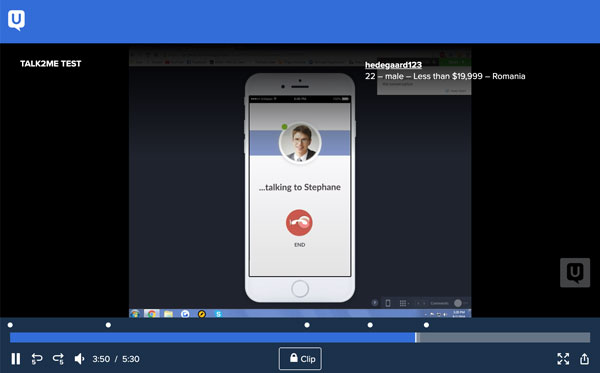
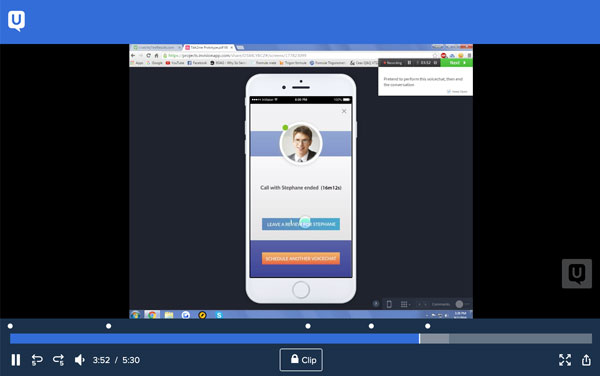


 This website uses exclusively technical cookies
This website uses exclusively technical cookies